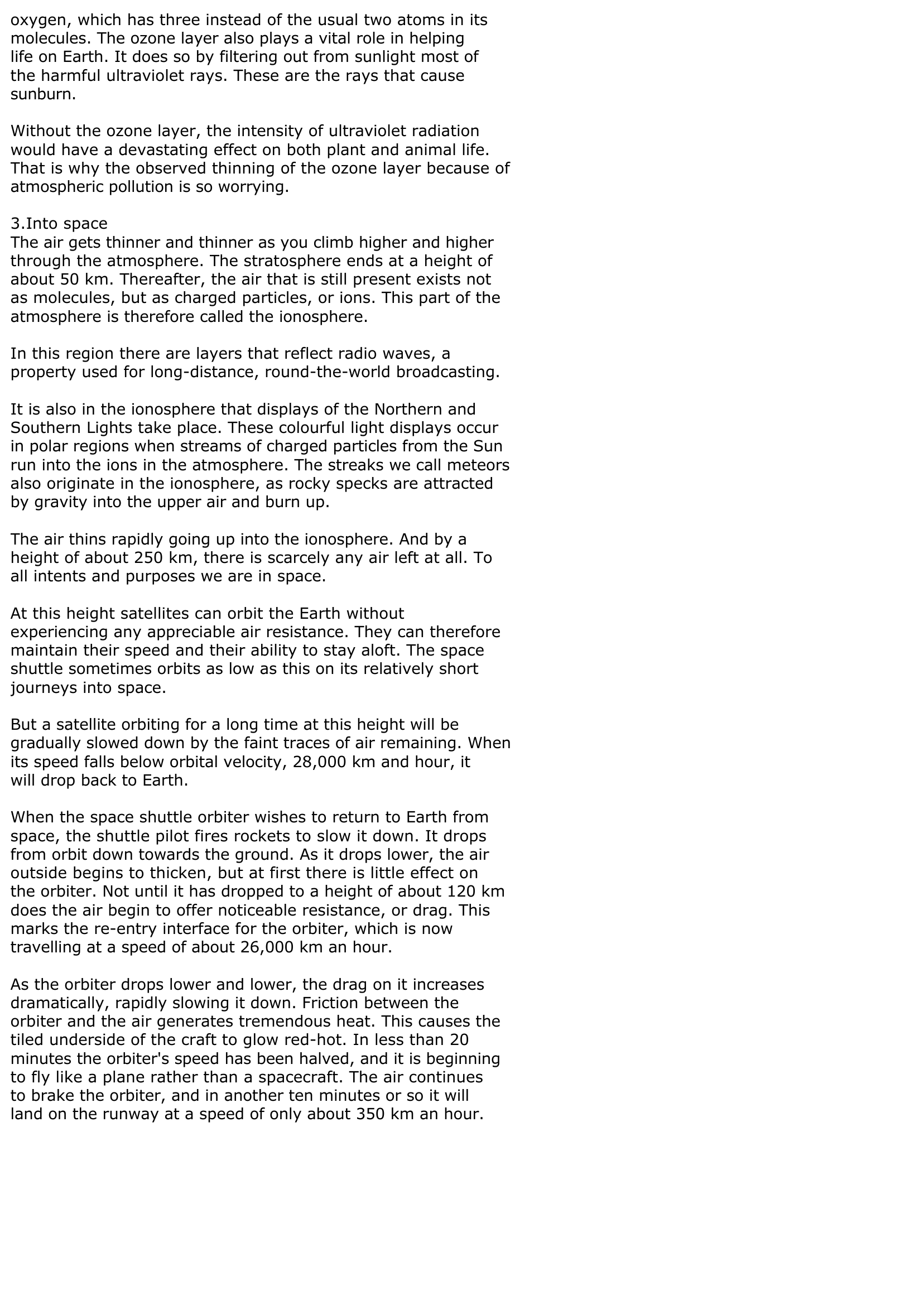EARTH, ATMOSPHERE AND SPACE
Publié le 22/02/2012

Extrait du document
«
oxygen, which has three instead of the usual two atoms in itsmolecules.
The ozone layer also plays a vital role in helpinglife on Earth.
It does so by filtering out from sunlight most ofthe harmful ultraviolet rays.
These are the rays that causesunburn.
Without the ozone layer, the intensity of ultraviolet radiationwould have a devastating effect on both plant and animal life.That is why the observed thinning of the ozone layer because ofatmospheric pollution is so worrying.
3.Into spaceThe air gets thinner and thinner as you climb higher and higherthrough the atmosphere.
The stratosphere ends at a height ofabout 50 km.
Thereafter, the air that is still present exists notas molecules, but as charged particles, or ions.
This part of theatmosphere is therefore called the ionosphere.
In this region there are layers that reflect radio waves, aproperty used for long-distance, round-the-world broadcasting.
It is also in the ionosphere that displays of the Northern andSouthern Lights take place.
These colourful light displays occurin polar regions when streams of charged particles from the Sunrun into the ions in the atmosphere.
The streaks we call meteorsalso originate in the ionosphere, as rocky specks are attractedby gravity into the upper air and burn up.
The air thins rapidly going up into the ionosphere.
And by aheight of about 250 km, there is scarcely any air left at all.
Toall intents and purposes we are in space.
At this height satellites can orbit the Earth withoutexperiencing any appreciable air resistance.
They can thereforemaintain their speed and their ability to stay aloft.
The spaceshuttle sometimes orbits as low as this on its relatively shortjourneys into space.
But a satellite orbiting for a long time at this height will begradually slowed down by the faint traces of air remaining.
Whenits speed falls below orbital velocity, 28,000 km and hour, itwill drop back to Earth.
When the space shuttle orbiter wishes to return to Earth fromspace, the shuttle pilot fires rockets to slow it down.
It dropsfrom orbit down towards the ground.
As it drops lower, the airoutside begins to thicken, but at first there is little effect onthe orbiter.
Not until it has dropped to a height of about 120 kmdoes the air begin to offer noticeable resistance, or drag.
Thismarks the re-entry interface for the orbiter, which is nowtravelling at a speed of about 26,000 km an hour.
As the orbiter drops lower and lower, the drag on it increasesdramatically, rapidly slowing it down.
Friction between theorbiter and the air generates tremendous heat.
This causes thetiled underside of the craft to glow red-hot.
In less than 20minutes the orbiter's speed has been halved, and it is beginningto fly like a plane rather than a spacecraft.
The air continuesto brake the orbiter, and in another ten minutes or so it willland on the runway at a speed of only about 350 km an hour..
»
↓↓↓ APERÇU DU DOCUMENT ↓↓↓
Liens utiles
- NASA (National Aeronautics and Space Administration).
- EADS [European Aeronautic Defence and Space Company] (entreprise).
- Cockroach Cockroaches are one of the oldest insects on Earth and look about the same as they did millions of years ago.
- Plutus Greek Son of Demeter and Iasion, son of Zeus and Electra (2); god of wealth and of the Earth's abundant harvests.
- Prometheus (Forethought) Greek One of the Titans, descended from the Earth Mother (Gaia) and the Sky Father (Uranus); son of Iapetus and one of the daughters of Oceanus, possibly Clymene; brother of Atlas and Epimetheus; father of Deucalion.










